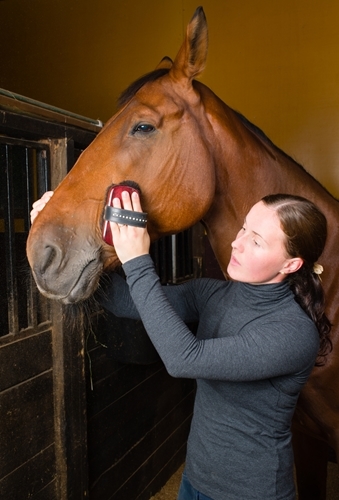Grooming covers more than aesthetics – it is also an essential part of horse care. Besides keeping the horse’s skin and coat in good condition, it gives you the chance to check for parasites, injuries, swelling and areas of soreness. Grooming is also a great way to bond with your horse. To make sure you and horse get the most out of grooming, here are some tips:
1. With a rubber curry comb, use a circular motion to loosen mud, dirt, sweat, hair and scurf (the grayish guck made of skin oil, dandruff and dust that gathers on the brush). This helps prepare the coat for the upcoming brushes. As with all of the brushes, begin on the left side at the top of the neck and work your way to the hind end and repeat on the right side. While this comb can be used over the horse’s whole body, be sure to use it gently over bony areas.
For those who prefer a plastic curry comb, do not use it on the head, legs or other sensitive areas where the skin is thin. The comb’s longer and more rigid, which can irritate the skin. Some equine experts point out that the plastic curry might be too hard for some horses.
2. Afterward, use the dandy brush, which is also known as a stiff or hard brush. Its long, stiff bristles remove hair and dirt loosened by the curry comb. It should be applied in short, firm strokes in the direction of hair growth that end in a small flick to remove grunge right off the coat.
3. As you groom, keep an eye out for injuries, skin irritations and areas of sensitivity. Grooming is hygienic care, which decreases the chance of health problems such as thrush, scratches and other skin problems. Gently run the brush over skin while monitoring for cuts, swelling and lameness.
4. The soft bristles of the body brush extend right down to the skin, removing dirt and leaving a shine. Use the body brush in firm, sweeping strokes in the direction of hair growth. This brush can be used on all areas of the body, including the face.
Brushing the face requires special care, as it is one of the most sensitive areas of a horse’s body. A smaller version of the body brush, aptly called a face brush, can simplify this step. Sweep gently, avoiding brushing dirt into the eyes. Take care around the face’s bony bits. As the brush picks up dirt and hair, it becomes less effective, so clean it every few strokes by scraping the bristles against a plastic or metal curry comb.
5. Next come the mane and tail. Horse owners do not have to brush the tail every day, but using a spray or rub-in mane and tail conditioner can clean out these areas and help prevent hair loss. Manes and forelocks can be untangled by hand and finished with the body brush.
When you go to brush the tail, stand to one side and gently pull the tail toward you. Pluck out shavings and other debris with your fingers, and then use another sponge to clean the horse’s dock and under it and the sheath or udder.
Lastly, rub the horse with a soft folded towel, which will help stimulate the production of skin oils and elicit the shine in the coat.
Ideally, a coat should be cleaned every day.
Extra horse grooming tips
- Sponging a horse’s face after exercise helps prevent fungal hair loss.
- Since dark coats often fade in the sunlight, provide lots of shade for darker equines. To further maintain the coat’s sheen, rinse a sweaty horse before letting it bask in the sun – sweat accelerates the fade.
- Don’t overbathe your horse – shampooing too frequently may dull its coat.
- Protect against skin infections by regularly disinfecting grooming brushes and combs.
- When you are braiding, banding or even training a mane over to one side, use a mane mousse to get wayward hairs under control.









